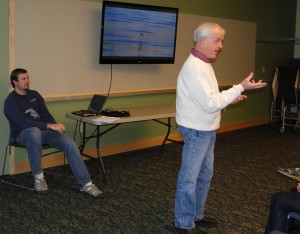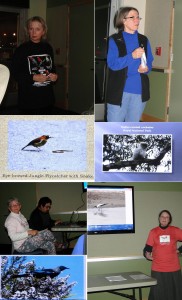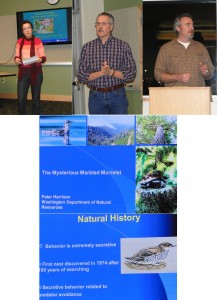Need a set of volunteers to count Vaux Swifts at JBLM by this weekend!!!
From: Burney.Huff@mindspring.com Date: Wed, 24 Apr 2013 16:09:12 -0700
Hello to all, Earlier today I was notified that permission to count Vaux Swifts at JBLM has been granted!
Now, I need to assemble a team of volunteer counters as quickly as possible. Small numbers of birds have been arriving at chimneys in Western WA on recent nights. If you may be interested in counting during this Spring migration, here are the basic facts you need to know. The observer needs to be on site at the chimney about an hour before sunset, in anticipation of birds actually entering the chimney up to an hour later. On May 1 (about the earliest we can possibly start) sunset will occur at about 8:15 PM. Birds might enter as late as about 9:15 PM. At the end of May, when the migration will probably be about over, sunset will occur about 9:00 PM, with the birds entering by approximately 10:00 PM. The point is that the observation periods in the Spring get to be fairly late in the evening, which is difficult for some people. But, a big compensating factor is that some evenings are really beautiful in the Spring. (Maybe we will be able to watch the Red-breasted Nuthatches feeding their young while we count swifts again this year?)
Volunteers will need transportation to get to the chimney, which is an easy driving distance from the JBLM Main Gate or the DuPont Gate. Volunteers that already have access to the base will NOT need to get a separate visitor’s pass this year. Volunteers who do not have access to the base will need to provide me with their full name. I will forward those to our contact on the base who will, in turn, send the list to Base Security. When that happens, volunteers will be able to go to the Visitor’s Center, at the Main Gate, and get a 30-day visitor’s pass. To get the pass, each volunteer will need to show: 1) a drivers license, 2) vehicle registration, and 3) proof of insurance (all the normal things you should have in the vehicle when driving, anyway). If your vehicle needs to have an emissions test, you will also need a copy of a current certificate of passing the emissions test. Emissions tests are required for vehicles more than five years old and less than 25 years old and registered in Pierce or King Counties.) If you don’t have a copy of your certificate, I can tell you how to get a copy online. The 30-day visitor’s pass will need to be obtained on your first visit to the base. I recommend being at the Visitor’s Center about 45 minutes before you hope to arrive at the chimney. The time required to actually get a pass varies, depending on how busy the office is. You need to be aware that when you show them your driver’s license, they will run a check on the license – similar to the check that a police officer might run if you are stopped on the highway. It’s not a big deal. They just need to make sure you are an upstanding citizen, and who you say you are, before they give you access to the base. I appreciate their efforts to keep the base secure, as I’m sure all of you do, too.
For those who have not counted Vaux’s Swifts before, I will accompany you on your first night at the chimney to help you get comfortable. I’ll follow up on subsequent nights, if you want. We won’t leave you wondering how to proceed.
This is a fantastic opportunity to do some birding of a very different sort. It’s also an opportunity to see something absolutely amazing when all the swifts decide to enter the chimney. It can get to be a jaw-dropping experience. If you are interested and have other questions, please fire away with your questions. I’ll get them answered promptly.
Please let me know by Sunday, 4/28, by email, if you will be able to count this spring. I sincerely apologize for the short notice; but, we’ve been waiting to find out if our request for access was going to be approved. I got the good news only a few hours ago.
If you know anyone else who might be interested in doing this, please forward this email to them.
When we get a team of volunteers identified, I’ll send more details about how to get the visitor’s pass, etc.
Burney Huff Burney.Huff@mindspring.com




